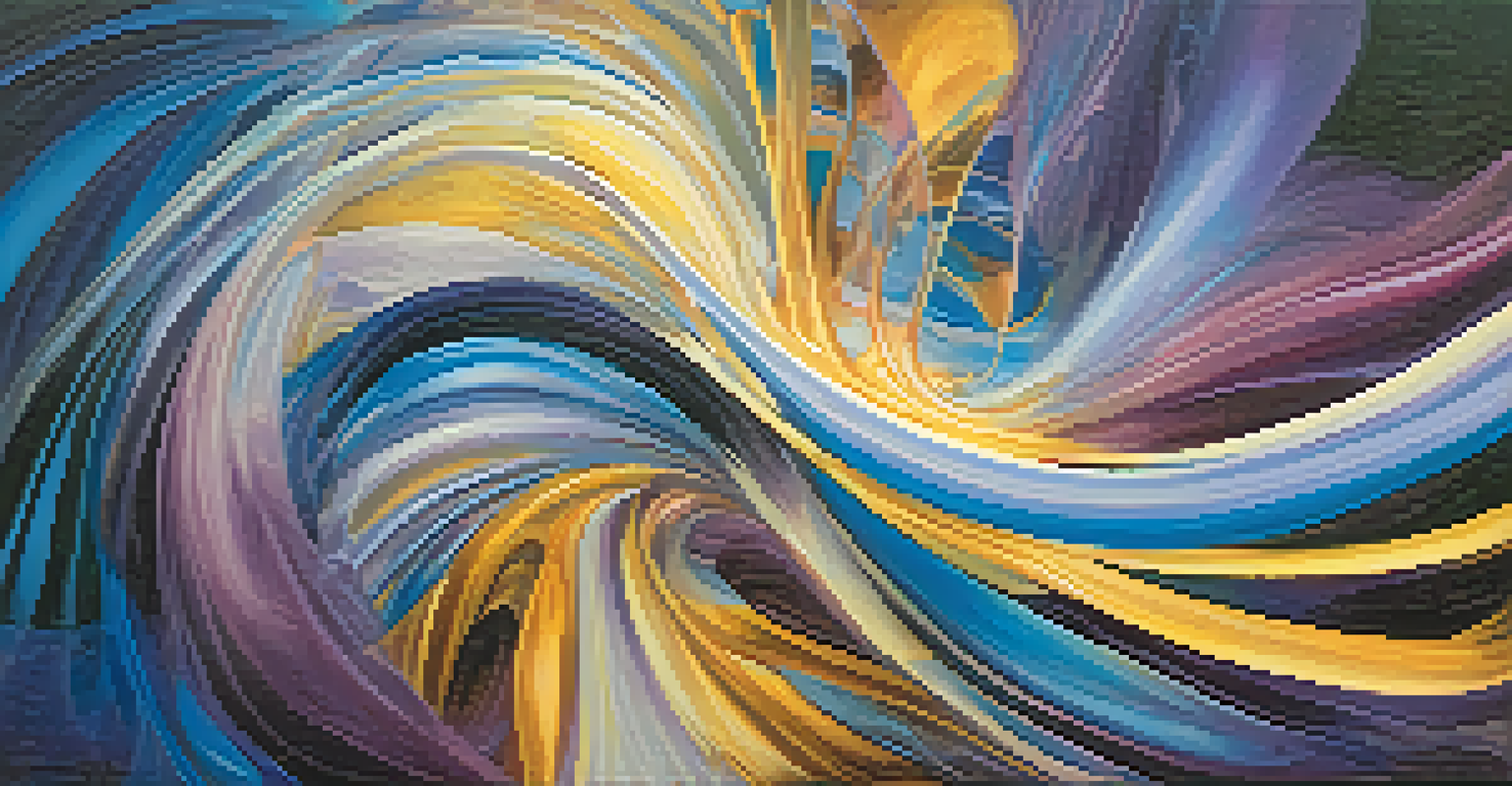Psychedelics and the Fabric of Reality: A Philosophical Inquiry

Understanding Psychedelics: A Brief Overview
Psychedelics, such as LSD and psilocybin, have fascinated humans for centuries. These substances alter perception, mood, and cognitive processes, leading to profound experiences that many describe as life-changing. Often classified as hallucinogens, they can evoke vivid imagery, deep emotional insights, and a sense of connectivity with the universe. Understanding these substances is the first step in appreciating their impact on our perception of reality.
Psychedelics can help us see the world in a different way, transforming our understanding of reality and consciousness.
Recent scientific research has begun to shed light on how psychedelics interact with the brain. They primarily affect serotonin receptors, which play a crucial role in mood regulation and perception. This interaction can lead to altered states of consciousness, prompting users to experience reality in novel ways. As we delve deeper into these experiences, we begin to question what reality truly is.
Throughout history, various cultures have used psychedelics as tools for spiritual exploration and healing. From the ancient shamans of South America to modern therapeutic settings, these substances have been integral to understanding human consciousness. The rich tapestry of these experiences invites us to reflect on the nature of reality itself and our place within it.
The Nature of Reality: Philosophical Perspectives
Philosophers have long debated the nature of reality, asking questions like, 'What is real?' and 'How do we know it?' This inquiry becomes even more intriguing when considering the effects of psychedelics. These substances can reveal layers of consciousness that challenge our conventional understanding of existence. In essence, they can act as a mirror, reflecting our thoughts, fears, and aspirations back to us.

One prominent philosophical perspective is idealism, which suggests that reality is fundamentally mental and immaterial. When under the influence of psychedelics, users often report experiences that align with this view, feeling as if their thoughts shape the universe around them. This raises fascinating questions about the interconnectedness of mind and matter, prompting us to reconsider how we define reality.
Psychedelics Alter Consciousness
Psychedelics like LSD and psilocybin can significantly change perception, leading to profound insights and altered states of consciousness.
Conversely, materialism posits that reality is purely physical and independent of our perceptions. Yet, the experiences induced by psychedelics can blur these lines, suggesting a more complex relationship between consciousness and the material world. This interplay invites an examination of how our perceptions may not just reflect reality, but actively participate in creating it.
Psychedelics and Altered States of Consciousness
Altered states of consciousness are a hallmark of psychedelic experiences. Users often report feelings of unity, transcendence, and a dissolution of the self, which can lead to profound insights about life and existence. These states challenge the conventional boundaries of the mind, suggesting that our understanding of consciousness is far from complete. By exploring these altered states, we can gain a deeper appreciation of the human experience.
The use of psychedelics can be a profound experience that allows individuals to explore the depths of their consciousness and the nature of existence.
One notable phenomenon in psychedelic experiences is ego dissolution, where individuals feel a loss of their personal identity. This can lead to feelings of oneness with the universe, prompting questions about individuality versus universality. In this state, users often describe a sense of peace and interconnectedness, which can reshape their understanding of reality once the experience ends.
Research indicates that these altered states can have therapeutic benefits, helping individuals confront past traumas and emotional blockages. By navigating these experiences, users may emerge with a renewed perspective on life. This therapeutic potential highlights the importance of understanding how psychedelics can influence our consciousness and ultimately, our reality.
Cultural Context: Psychedelics Through History
The use of psychedelics is not a modern phenomenon; it has deep historical roots in various cultures around the world. Indigenous tribes have utilized these substances for centuries in rituals and healing practices, viewing them as gateways to spiritual realms. This cultural context provides a rich backdrop for understanding the role of psychedelics in shaping human consciousness and reality.
In the 1960s, psychedelics gained popularity in Western societies, often associated with counterculture movements. Figures like Timothy Leary championed their potential for expanding consciousness and challenging societal norms. However, this period also led to backlash and stigmatization, resulting in strict regulations that hindered further exploration of their benefits. Understanding this historical narrative helps contextualize the modern resurgence of interest in psychedelics.
Cultural Roots of Psychedelic Use
Historically, various cultures have utilized psychedelics for spiritual exploration and healing, shaping our understanding of consciousness.
Today, there is a renewed interest in the therapeutic applications of psychedelics, particularly in mental health treatment. As society begins to re-evaluate these substances, we can draw from historical practices to inform contemporary use. By honoring the wisdom of ancient cultures, we can navigate the complexities of psychedelics and their impact on our understanding of reality.
The Science Behind Psychedelics and Perception
Scientific research into psychedelics has surged in recent years, revealing their potential to alter perception and consciousness. Studies have shown that psychedelics can enhance sensory experiences, leading to heightened awareness of colors, sounds, and even emotions. This neurological shift encourages us to consider how our perception shapes our reality and how psychedelics can expand those boundaries.
Functional Magnetic Resonance Imaging (fMRI) scans demonstrate that psychedelics can increase connectivity between different regions of the brain. This increased communication may explain the profound insights and altered states users experience. By mapping these changes, researchers are uncovering the intricate relationship between brain function and consciousness, challenging traditional views of how we perceive reality.
As we continue to explore the science behind psychedelics, we uncover valuable insights into human consciousness. This growing body of research not only enhances our understanding of psychedelics but also invites a broader discussion on the nature of reality itself. The intersection of science and personal experience offers a unique lens through which we can examine the fabric of existence.
Psychedelics and Spirituality: A Personal Journey
Many individuals who experiment with psychedelics report profound spiritual experiences that transform their understanding of existence. These journeys often evoke feelings of connection, love, and enlightenment, blurring the lines between self and the universe. Such experiences can lead to lasting changes in one’s worldview, prompting individuals to seek deeper meaning and purpose in their lives.
For some, psychedelics serve as a catalyst for spiritual exploration, facilitating connections with a higher power or the cosmos. These experiences can be deeply personal, often leading to revelations about one’s place in the universe. This spiritual dimension adds another layer to the discussion of reality, suggesting that our understanding of existence may extend beyond the physical realm.
Future of Psychedelics in Therapy
Ongoing research into psychedelics is uncovering their therapeutic potential, which may reshape societal attitudes and mental health practices.
However, it’s essential to approach these experiences with care and intention. Not all encounters with psychedelics are positive, and understanding the potential risks is crucial. By framing these journeys within a context of respect and mindfulness, we can navigate the complex relationship between psychedelics, spirituality, and reality.
The Future of Psychedelics in Understanding Reality
As interest in psychedelics continues to grow, so does the potential for new discoveries about consciousness and reality. Ongoing research is exploring their applications in mental health, spirituality, and even creative problem-solving. This exploration could reshape our understanding of what it means to be human and how we engage with the world around us.
The future may also see a shift in societal attitudes towards psychedelics, leading to increased acceptance and integration into therapeutic practices. By breaking down the stigma surrounding these substances, we can unlock their potential for healing and personal growth. This shift could pave the way for more profound insights into the fabric of reality and our place within it.

As we stand at the crossroads of science, spirituality, and philosophy, the exploration of psychedelics offers a unique opportunity to deepen our understanding of existence. By embracing this journey with openness and curiosity, we can unravel the complexities of consciousness and reality, ultimately enriching our human experience.